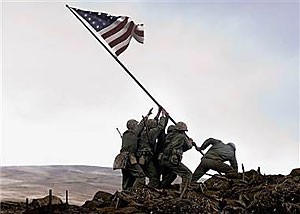Looks like one Oscar wasn’t enough for Clint Eastwood. Nothing’s more likely to win the gold statue than a big-budget World War II epic, and he’s just made a damned good one.
“”Flags of Our Fathers”” confirms the fact that Clint Eastwood is every bit as fierce behind the camera as he is in front of it.
The movie tells the tale of young men sent from training camp to take part in the battle of Iwo Jima. The generals build up a heightened sense of meaning of the battle to their soldiers because of the strategic importance of the island.
The battle is anything but easy; the Americans and the Japanese slug it out with no real winner but produce a lot of dead bodies along the way. One of the newspaper photographers who’s imbedded with the troops captures one of the few hopeful moments in the fight – when six men raise the American flag atop a hill.
The picture is soon plastered over the front of all the newspapers, and national curiosity is peaked over who these men are. The government pulls three of the men off the battlefield to send them on a promotional tour of the United States: John Bradley (Ryan Phillippe), Rene Gagnon (Jesse Bradford) and Ira Hayes (Adam Beach).
The men are forced into becoming the talking heads for the government to try to entice the nation to buy more war bonds. With the constant reminder of having to recreate the scene on Iwo Jima, the men slowly begin to feel conflicted about how they’re now safe while their fellow soldiers are still risking death every day.
The original photo by Joe Rosenthal proved that a picture really is worth a thousand words, so it would be a shame if the cinematography here was less than beautiful. The movie is shot with a grayish-blue tone, which adds to the dark and dirtiness of the battle scenes. The darkness helps to add an even more sinister feeling.
“”Flags of Our Fathers””
R
132 min
Dreamworks Pictures
Score: 10/10
The interesting part of the shooting is that the camera doesn’t always focus on the main characters. At times, you almost lose them in the huge mass of troops in green. It helps add to the chaos of the rapid fire of invading the island; you don’t even have time to register what’s happening.
By not focusing on the main characters, Eastwood strengthens the theme that the three men who took part in the flag-raising were just a few of many heroes who deserved equal recognition and honor.
Most war movies have a tendency of going over the top and touting their own flag (if you’ll pardon the pun). Surprisingly, even though “”Flags of Our Fathers”” is based around the significance of the U.S. flag, it restrains itself from shoving patriotism overtly down your throat. You are moved by the events on your own accord, not because the movie forces you to be.









